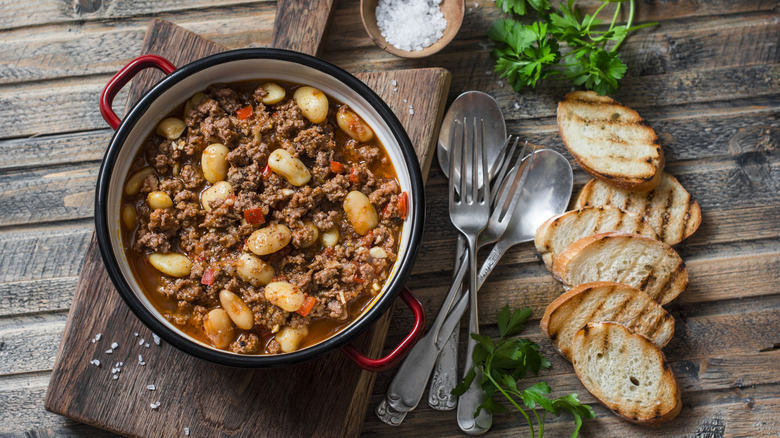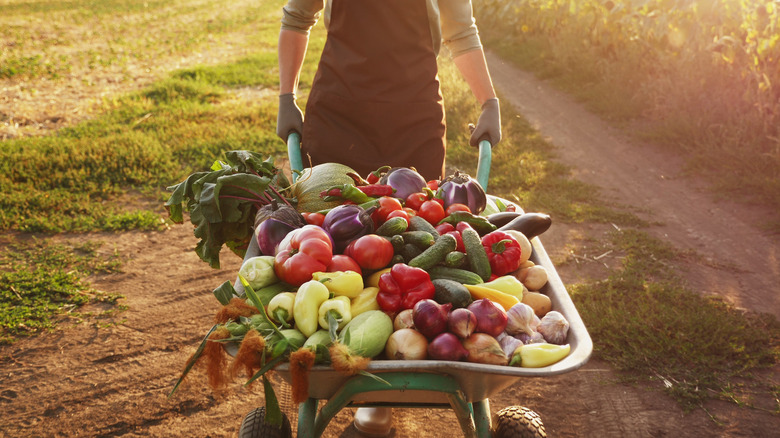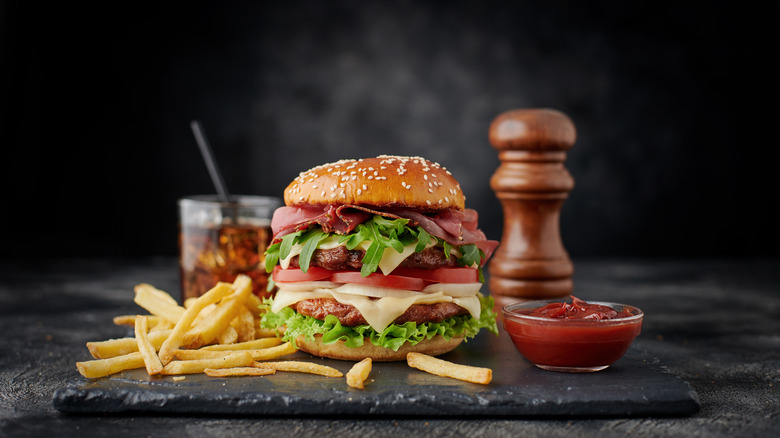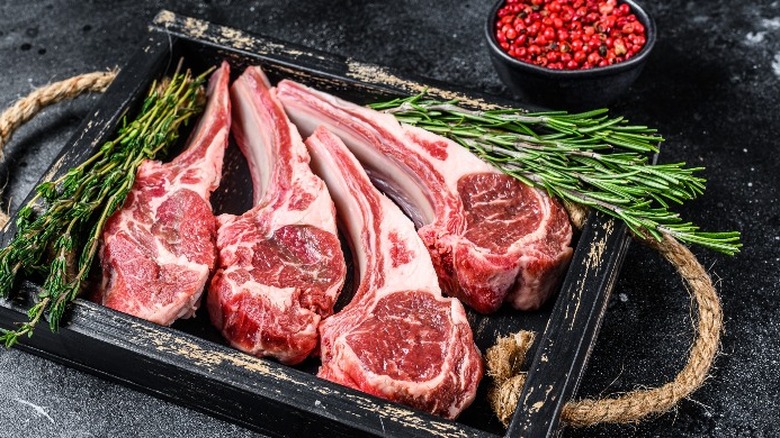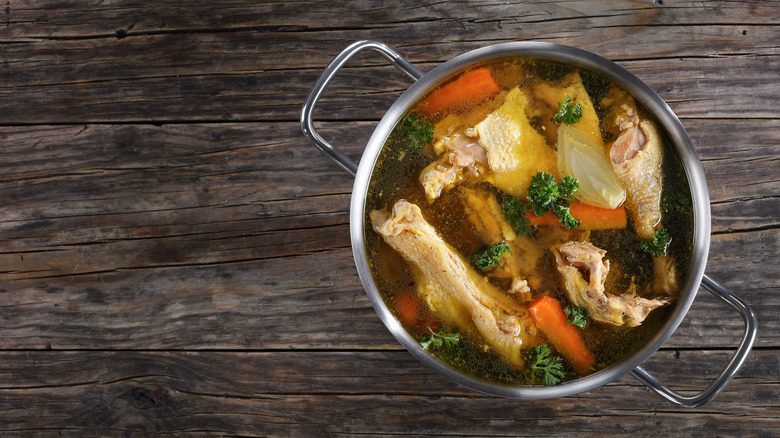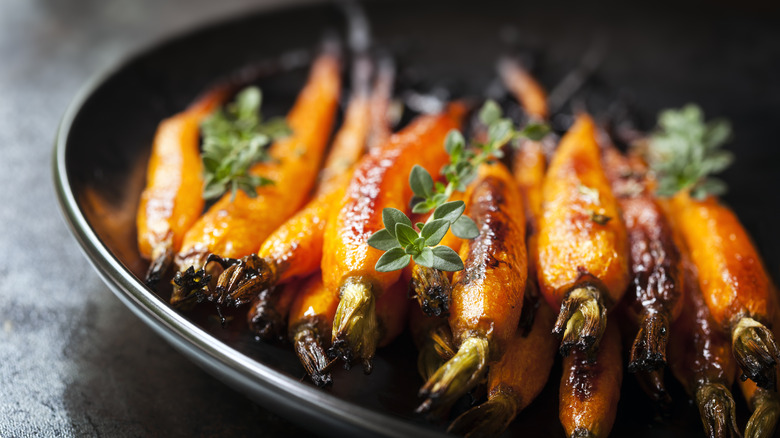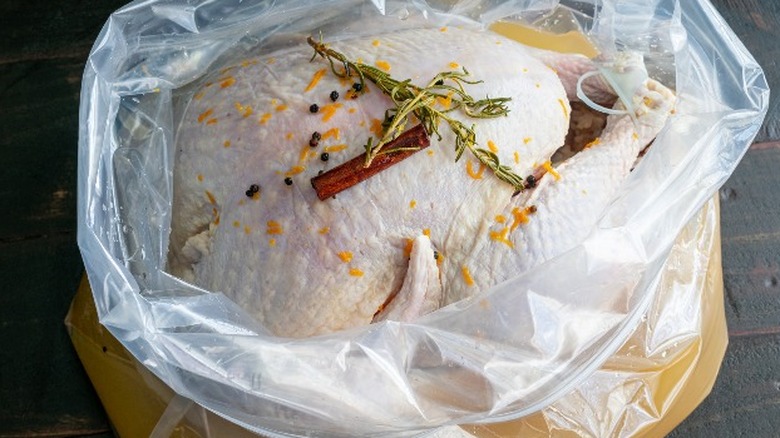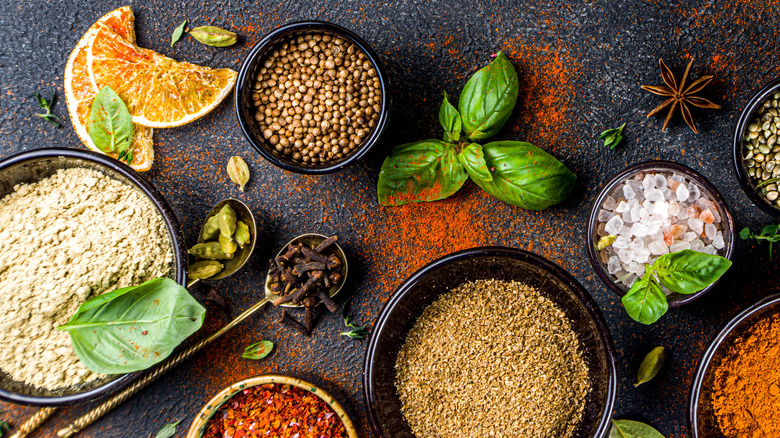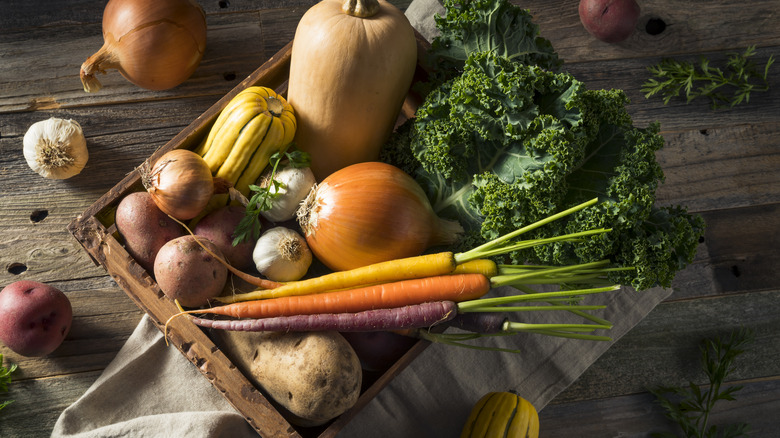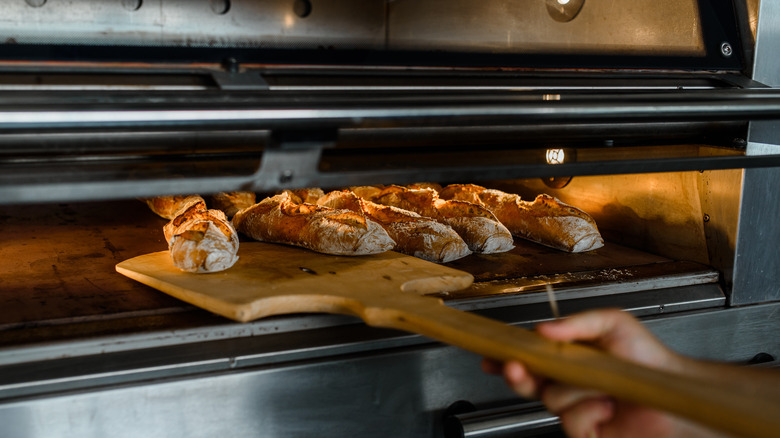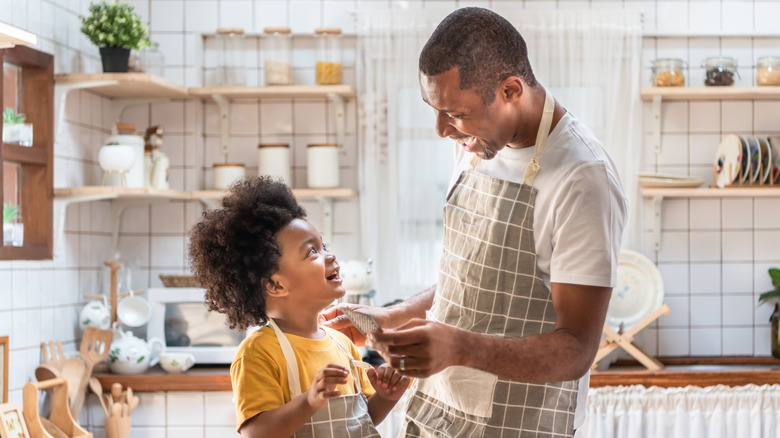Marcus Samuelsson's 11 Best Cooking Tips For Home Chefs
Marcus Samuelsson is probably recognizable to some from his tenure on Top Chef All-Stars, Chopped All-Stars, No Passport Required, and Undercover Boss. How about his seven cookbooks and one incredibly personal and touching memoir? He's also the founder of 12 different and wildly successful restaurants, each one built to his exacting specifications based on his desire to reduce waste while serving the community that they're based. He's also the guy with a serious passion for flavors, like his beloved berbere.
Ethiopian born and raised by an adoptive Swedish family, notes The History Makers, Samuelsson's upbringing has certainly informed his outlook and style of cooking; he credits Swedish grandmother Helga with starting him on the journey to becoming a chef, while he also credits the flavors of Ethiopia for giving him the desire to try more. Here is our look at the top tips that this phenomenal chef and raconteur has for aspiring chefs and home cooks alike.
Learn how to make slow-cooked meals
Samuelsson is pretty outspoken when it comes to using cheaper cuts of meat, not only for budgetary reasons but also because of all that flavor. Cheaper cuts, especially beef or pork, have loads more flavor than, say, a wildly expensive tenderloin. Sure, that tenderloin is pretty foolproof when it comes to cooking techniques; when cooked properly, it will always be succulently juicy and tender. But don't overlook the cuts that need a little more attention, because they will have so much more flavor. Cheaper cuts tend to have tougher fibers because they often come from more muscular parts of the animal. Don't forget... muscle means flavor. On top of that, Samuelsson assures us that a big pot of slow-cooker chili or oxtail soup will feed you and your family for more than one meal.
Muscular cuts have far less fat, and so they need to be babied just enough to bring out their best qualities. Slow cooking is the way to go with anything that has loads of connective tissue that needs to be broken down. That melted connective tissue, which is essentially collagen, makes the meat softly tender and the sauce silky and unctuous, (via Rib 'N Reef Steakhouse). Beyond that, slow-cooking also ensured that your delicious meal will be cooked all the way through, rather than those still-cold-inside barbecued chicken breasts.
Take advantage of your local butchers and farmers' markets
Supporting butchers and farmers' markets in your community not only means that you're generally buying local, but it also gives you the opportunity to get to know the people who are supplying a lot of your food. Think of those producers as a valuable resource for all the information you could ever need about what they're selling. Want to try the kind of unusual Jerusalem artichoke but have no idea how to prepare it? What if you're looking for a pork belly for a particular recipe but can't find one in your grocery store? Dealing with a person who specializes in specific foodstuffs is probably the best way to get all your questions answered, and more. Not only that, but you'll also find that buying from smaller, local producers will give you fresher meat and produce. And that's always a good thing.
In his memoir, Yes, Chef, Samuelsson explains how local markets helped him to rediscover some of the biggest missing pieces of his Ethiopian past as far as food goes. Not only through sights and smells, but also because of the knowledge he gleaned from the people he met there. Specifically, the woman who taught him how to make doro wat, a traditional Ethiopian dish, stands out in his mind for helping him to unearth knowledge he was lacking.
Try grinding your own burger meat
You don't have to trust just Samuelsson on this one. If you've followed the previous advice, you should now have a butcher you can confirm this one with, too. Freshly ground meat will make such a huge difference in the quality of your burgers that you'll wonder why you never thought of doing it before now. And before you pass this off as being too much work, believe us when we tell you that it's absolutely worth the little bit of extra effort. In fact, it's possible to do it with a food processor if you don't want to splash out for a grinder or, if you're really serious about burger quality, you can even see why hand-mincing is better than buying ground meat and get out your best knife.
In a post on Oprah.com, Samuelsson recommended that your meat be at least 30% fat for the juiciest and most flavorsome burger. He also suggests that you give those gorgeous patties a few minutes to rest before digging in, in order to let the juices distribute so that every bite is tasty and moist. And you don't have to stop with just burgers; grinding your own meat will make your meatballs, kebabs, or tourtière significantly better. One of the best reasons to try your hand at grinding meat is so that you know exactly what is going into the blend and have the ability to make your own combinations.
Use bone-in meat for juicier flavor
Again, Samuelsson makes a case for using cheaper cuts of meat for flavor. A whole chicken that you cut apart yourself (it's not that hard to do, we promise) will cost quite a bit less than buying all those same parts cut up with bones removed. And you'll be missing out on all the delicious flavor of bone-in meat, compared to the milder taste of boneless protein. Including the bones during cooking also allows the meat to retain more of the juiciness that you crave in your dinner.
While he uses bone-in meat whenever he can, Samuelsson is the most particular about using it when making the fried chicken that has made his stunning Harlem restaurant, Red Rooster, famous. Bone-in dark meat is his preferred type of meat for juicy fried chicken. Dark poultry meat is far more flavorful than white, and the inclusion of the bone means that Samuelsson's diners rave about his superb fried chicken. His crunch-ensuring double-fry technique can't hurt, either.
Leaving the bone intact acts as an insulator, according to Smoking Meat Geeks, making sure that the meat surrounding it doesn't get too hot and, therefore, overcooked. As the temperature difference can be up to 10%, it also means that you'll need to take care to avoid the bony bits when using a meat thermometer.
Use what you already have on hand
Chef Samuelsson has always been outspoken about making use of what you already have on hand, particularly at his new restaurant Hav & Mar. There, the focus is on reusing leftover or extra ingredients through fermentation or other means. This ethical outlook is something he attributes to being raised by his Swedish grandmother Helga, who never let anything go to waste. Much of his early culinary education came from her and he continues to make use of those skills in the restaurants that he owns. Sustainability, recycling, and an inclusive community are all part of Samuelsson's mode of operation.
So what does this mean in the kitchen? Recycling or even composting is fine. Sure, you can turn leftover pickle juice into brined fried chicken. But what about going a step further, by using as much of the item as you can — meaning the stems, stalks, livers, or fat? Samuelsson advocates for reusing everything, including a plain old dish of leftovers in ways that are easy and, more importantly, even delicious. All those succulently roasted bones from your bone-in chicken will add substantially more flavor to an upgraded broth. Something as simple as just adding a squeeze of lime or some bright herbs will freshen up that dish perfectly.
Caramelize your veggies for richer flavor
Not one to focus solely on meat, Samuelsson advises giving your veggies the high heat treatment in order to bring out their best flavors. Since fruits and vegetables do have a bit of sugar in them, roasting gives them that prized, caramelized coating that really adds oomph. And this goes beyond just a roasted carrot side dish — imagine how much depth those gorgeous little brown bits will add to any sauce or gravy you might be making. If you've ever had a gumbo that blew your mind, then you'll know how much flavor that little bit of brown can add.
In this instance, Samuelsson uses the example of making chicken soup (with all the perfect leftovers that he loves) to show why roasted veggies are the flavor bomb that will save your dinner. Not only will they add more depth of flavor but they'll give anything you make a boost of color, which is important because pale food can equal bland food. Those roasted veggies will add a definite sweetness — it is called caramelization, after all — as well as round out whatever you're making. This even applies to veggie scraps, if you're well into the idea of reducing your food waste. Just roast those scraps first and then make your delicious dish as you normally would.
Learn how to use brine for juicy chicken
If you've spent the last decade reusing your leftover pickle brine on your poultry, then you might not need to read any further. If, however, you don't go through pickles at such an alarming rate, you can still concoct and manage a brine that will help to ensure that you roast up an ultra-juicy and tasty bird. Brining is a pretty easy way to guarantee that your roast poultry stays moist and full of flavor with a decadently crisp skin all without the extra work. You'll definitely need to schedule the brining time, but otherwise, it's a simple proposition. Samuelsson's recipe for cooking a juicy chicken recommends starting the day prior, which includes a four-hour brine and an uncovered, overnight rest in the refrigerator. That doesn't sound so bad, especially when you taste the final product.
Even this recipe is chock full of Samuelsson's previous recommendations — use whatever root veggies and any spices that you have on hand to flavor the dish (within reason) — sage, thyme, garlic salt, or a roasting blend would all be incredible here. Let that meaty beauty rest for 20 minutes before you dig in to let the juices redistribute.
Don't be afraid to experiment with flavors
After spending his formative years with an adoptive Swedish family, Samuelsson was finally able to spend some time learning about his Ethiopian roots. Specifically, he explored his heritage through the country's food and by learning all about the distinctive spice mixture known as berbere, which he refers to as his secret weapon spice blend. The literal and figurative distance between those two countries meant that the chef truly had to develop an understanding of the huge range of flavors that he loves to eat and use. To this day, he continues to use them in many of his recipes and often tries to spread the word about the value of experimentation with new herbs and spices.
His global approach to blending flavors always belies his multicultural background and, while the combinations can often seem a little incongruent, they definitely work as a mouth-watering whole. Take, for example, this incredibly delish summer crab and avocado sandwich that showcases just how in-tune Samuelsson is with the multitudes of tastes at his eager fingertips. Packed full of fresh herbs, slathered with an incredible citrusy and Japanese-inspired togarashi mayo, and topped with some of his beloved pickled tomatoes — a callback to his grandmother's penchant for reusing and salvaging everything on hand. This light sandwich is chock full of flavor and texture.
Develop an understanding of seasonality
Seasonality means seeking out and buying vegetables at their peak, rather than just mindlessly consuming asparagus in November or squash in June, or whenever you're craving it and can pick one up at a big box store. Instead, this particular tenet takes advantage of veggies at the height of their freshness, but it also means that you're not paying extra for greens that have traveled for miles and miles. That long drive, by the way, will also really impact the freshness of what you're eating, making that asparagus stringy, tough, and bitter. Why not wait until June and pick up some truly exquisite spears, instead?
Chef Samuelsson, as we've already discussed, calls on his upbringing to explain why he was first called on to make use of the food at hand — and that often means what you can grow yourself, if possible. Otherwise, farmers' markets are, again, the way to go here. We get it, not all of us live in a place that can host year-round farming. But even doing some basic research will tell you why Brussels sprouts are a must-have at Thanksgiving, rather than at the Easter table. Need a little help? The U.S. Department of Agriculture has a terrific tool for making choices that outlines what is fresh, and when, in America.
Ditch the microwave for better-tasting meals
Trust us, we get it. Sometimes, you're in a rush, or maybe you're just used to using that big beeping box on the counter without thinking about it. Or it's the only warming device in the lunchroom at work. But what if you didn't have to rely on it? Marcus Samuelsson suggests that you would absolutely be better off without a microwave. In fact, the chef might even go so far as to call it a banned kitchen tool in his own home and restaurants. He feels that while the device might save a little bit of time, the same food cooked on a stovetop comes out just as well, and perhaps even better.
There are loads of other options, including using a toaster oven or, for supreme crispiness, an air-fryer (which honestly, isn't much more than just a tiny countertop convection oven). Both of those are also multi-purpose, too. And let's not even get into the soggy or uneven cooking that microwave ovens are famous for. If you have the time, a microwave might not even be something on your list of appliances or even in your kitchen. Some of us have even figured out how to replace that space-hogging dinging box with our beloved cast-iron pans for the best stovetop cooking gear. Don't blame us, sometimes technology isn't all it's cracked up to be.
Share the experience of preparing food with your loved ones
Samuelsson has been incredibly outspoken about just how much his family has been and continues to be an integral part of his culinary journey, from everything he learned cooking with his Swedish grandmother to making pizza with his son, Zion. He asserts that cooking really needs to be a communal activity, notes Forbes, because of the sharing of participants' knowledge, and simply because it forms better and deeper connections with those you love. We couldn't agree more. Honestly, if you think that your family won't love you even more after a sublime dinner of buttermilk fried chicken and waffles, then you're just kidding yourself. Never has there been a more perfect match.
Cooking as a family is actually highly recommended, especially when you have smaller kids or teens who aren't all that likely to talk freely. According to Purdue University, cooking as a family is a way to help your kids understand their background through traditional foods. More than that, it also helps with math and communication skills, and it might just get them to try something new. They also seem to think that kids who help their families with the cooking might just be more inclined to help clean up afterward. Who are we to argue with that train of thought? It's worth a try, at least.

